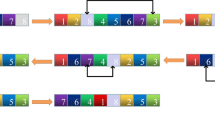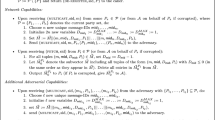Abstract
Watermarking techniques are developed to deal with multimedia distribution, authentication and copyright protection. It is usually the seller who embeds a watermark in multimedia content to identify the buyer. The embedded watermark can then be used to trace the traitors identity if unauthorized copies are found. However, repudiation and framing issues might arise in this approach. To solve these problems, buyer–seller watermarking protocols have been proposed based on watermarking in the encrypted domain. Such watermarks combine encryption, digital watermarking, and fingerprinting to preserve digital rights of both the buyer and the seller. Unfortunately, most existing watermarking techniques do not provide convincing proofs to ensure that they achieve the claimed level of security and informal proofs abound in the literature. In this paper, we propose a buyer–seller watermarking protocol based on proxy signatures and homomorphic encryption. Formal proofs are provided to show that in the proposed protocol, watermarks are generated such that the seller is unable to fabricate piracy, but he can trace copyright violators. The protocol further protects anonymity of the buyer until he is adjudicated to be guilty. Moreover, we solve the conspiracy problem without imposing any unrealistic assumptions about thrust-worthiness of the parties involved.


Similar content being viewed by others
References
Benhocine A, Laouamer L, Nana L, Pascu AC (2013) New images watermarking scheme based on singular value decomposition. Journal of Information Hiding and Multimedia Signal Processing 4(1):9–18
Boneh D, Shaw J (1995) Collusion-secure fingerprinting for digital data. In: Advances in cryptology–CRYPTO–95. Lecture notes in computer science, vol 963. Springer, Heidelberg, pp 452–465
Chang CC, Tsai HC, Hsieh YP (2010) An efficient and fair buyer–seller fingerprinting scheme for large scale networks, computers & security, vol 29, pp 269–277
Choi JHPJG, Sakurai K (2003) Does it need trusted third party? design of buyer–seller watermarking protocol without trusted third party. In: Applied cryptography and network security. LNCS 2846, pp 265–279
Cox IJ, Kilian J, Leighton T, Shamoon T (1997) Secure spread spectrum watermarking for multimedia. IEEE Trans Image Process 6(12):1673–1687
Deng M, Preneel B (2008) On secure and anonymous buyer–seller watermarking protocol. In: IEEE conference on internet and web applications and services
Eslami Z, Kazemnasabhaji M (2011) An efficient buyer–seller watermarking protocol based on proxy signatures. In: 8th international isc conference information security and cryptology (ISCISC), pp 73–78
Fan CI, Ming TC, Sun WZ (2007) Buyer–seller watermarking protocols with off-line trusted parties. In: IEEE conference on multimedia and ubiquitous engineering
Goi BM, Phan RCW, Yong Y, Bao F, Deng RH, Siddiqi MU (2004) Cryptanalysis of two anonymous buyer–seller watermarking protocols and an improvement for true anonymity. In: Applied cryptography and network security, pp 369–382
Hu X, Huang S (2007) A novel proxy key generation protocol and its application. Comput Stand Interfaces 29:191–195
Huang X, Mu Y, Susili W, Zhang F (2005) A short proxy signature scheme: efficient authentication in the ubiquitous world. In: Proc. of EUC workshops. LNCS, vol 3823, Springer-Verlag, pp 480–489
Hwang M, Tzeng S, Tsai C (2004) Generalization of proxy signature based on elliptic curves. Comput Stand Interfaces 26:73–84
Ju HS, Kim HJ, Lee DH, Lim JI (2002) An anonymous buyer–seller watermarking protocol with anonymity control. In: Information security and cryptology - ICISC, pp 421–432
Jurik IDM (2001) A generalisation, a simplification and some applications of paillier’s probabilistic public-key system. In: 4th international workshop on practice and theory in public-key cryptography, pp 119–136
Katzenbeisser S, Lemma A, Celik MU, van der Veen M, Maas M (2008) A buyer–seller watermarking protocol based on secure embedding. IEEE T Inf Foren Sec 3(4):783–786
Kim S, Park S, Won D (1997) Proxy signature, revisited. In: Proc. of ICICS’97, int. conf. information and communications security, vol 1334. Springer-Verlag, pp 223–232
Lai CC (2011) A digital watermarking scheme based on singular value decomposition and tiny genetic algorithm. J Digit Signal Process 21(4):522–527
Lee B, Kim H, Won K (2001) Secure mobile agent using strong non-designated proxy signature. In: Proc. of ACISP. LNCS, vol 2119. Springer-Verlag, pp 474–486
Lei CL, Yu PL, Tsai PL, Chan MH (2004) An efficient and anonymous buyer–seller watermarking protocol. IEEE Trans Image Process 13(12):1618–1626
Lian S, Chen X, Wang J (2012) Content distribution and copyright authentication based on combined indexing and watermarking. Multimed Tools Appl 57(1):49–66
Lin W-H, Horng S-J, Kao T-W, Fan P, Lee C-L, Pan Y (2008) An efficient watermarking method based on significant difference of wavelet coefficient quantization. IEEE Trans Multimed 10(5):746–757
Lin W-h, Horng S-j, Kao T-w, Chen R-j, Chen Y-h (2009) Image copyright protection with forward error correction. Expert Syst Appl 36(9):11888–11894
Khaled L (2012) On the security of digital watermarking scheme based on singular value decomposition and tiny genetic algorithm. Journal of Information Hiding and Multimedia Signal Processing 3(2):135–141
Mambo M, Usuda K, Okamoto E (1996) Proxy signature: delegation of the power to sign messages. IEICE Trans Fundam E79-A(9):1338–1354
Meerwald P, Koidl C, Uhl A (2009) Attack on “watermarking method based on significant difference of wavelet coefficient quantization”. IEEE Trans Multimed 11(5):1037–1041
Memon N, Wong PW (2001) A buyer–seller watermarking protocol. IEEE Trans Image Process 10(4):643–649
Paillier P (1999) Public key cryptosystems based on composite degree residuosity classes. In: Stern J (ed) Proc. Eurocrypt 99. LNCS 1592, pp 223–238
Poon TH, Miri A, Zhao J (2009) An improved watermarking technique for multi-user, multi-right environments. Multimed Tools Appl 42(2):161–181
Raphael CWP, Goi BM, Poh GS, Kim J (2011) Analysis of a buyer—seller watermarking protocol for trustworthy purchasing. Wirel Pers Commun 56(1):73–83
Rosenberg B (2010) Handbook of financial cryptography and security. A Champon and Hall book. CRC Press, pp 427–428
Schaathun HG (2008) On error-correcting fingerprinting codes for use with watermarking. Multimed Syst 13:331–344
Shao MH (2007) A privacy-preserving buyer–seller watermarking protocol with semi-trust third party. In: Trust, privacy and security in digital business. LNCS 4657, pp 44–53
Stinson DR (1995) Cryptography: theory and practice, 1st edn. Chapman & Hall, New York
Subramanyam AV, Emmanuel S, Kankanhalli MS (2012) Robust watermarking of compressed and encrypted JPEG2000 images. IEEE Trans Multimed 14(3):703–716
Wang Y-R (2011) An intelligent watermarking method based on particle swarm optimization. Expert Syst Appl 38(7):8024–8029
Yu Y, Xu C, Huang X, Mub Y (2009) An efficient anonymous proxy signature scheme with provable security. Comput Stand Interfaces 31:348–353
Zhang J, Kou W, Fan K (2006) Secure buyer–seller watermarking protocol. IEE Proc Inf Secur 153(1):15–18
Author information
Authors and Affiliations
Corresponding author
Rights and permissions
About this article
Cite this article
Eslami, Z., Kazemnasabhaji, M. & Mirehi, N. Proxy signatures and buyer–seller watermarking protocols for the protection of multimedia content. Multimed Tools Appl 72, 2723–2740 (2014). https://doi.org/10.1007/s11042-013-1555-0
Published:
Issue Date:
DOI: https://doi.org/10.1007/s11042-013-1555-0




